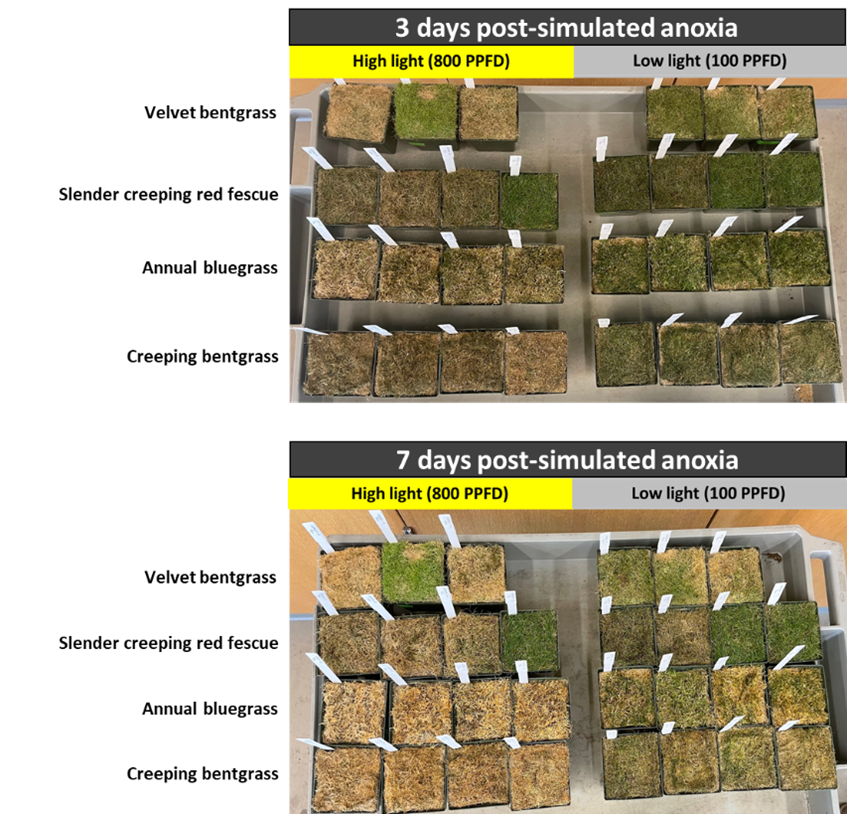By Michelle DaCosta, University of Massachusetts - Amherst
As part of collaborative projects in ICE-BREAKER (see blog post from April 2022) and WinterTurf, one of the major goals is to better understand factors impacting turfgrass survival associated with ice encasement. While we often focus on questions related to ice-induced damages due to lack of oxygen (i.e. anoxia), we do not have a good understanding of turfgrasses responses after plants are re-exposed to air following ice encasement, such as after natural melting events or mechanical removal of ice. A sudden re-exposure to air following anoxic conditions combined with low temperatures and high light intensities could result in a physiological shock as the grass is rebooting its metabolism. This may help to explain why turfgrasses sometimes rapidly deteriorate following ice encasement, even though the turfgrass stand may look relatively healthy upon initial inspection.
To study this interactive stress (sudden re-aeration following anoxia, low temperature, and high light intensities), we conducted a controlled environment experiment using growth chambers. Four turfgrass species were selected based on reported differences in their anoxia tolerance, including annual bluegrass, slender creeping red fescue, creeping bentgrass, and velvet bentgrass. The grasses were seeded and established for 8 weeks under optimal growing conditions, and then cold acclimated for 2 weeks at approximately 35°F. Following cold acclimation, the grasses were removed from pots and cut to approximately 0.5” soil depth (Figure 1).

To simulate ice encasement, the turf plugs were individually vacuum sealed in plastic sleeves to remove oxygen and induce anoxic conditions, shown in Figure 2. The sealed turf plugs were then placed at approximately 32°F in the dark for up to 6 weeks.

Turfgrasses were removed at 4 different time points including 1 day, 2 weeks, 4 weeks, and 6 weeks of incubation. At these time points, a syringe was used to sample the gas composition inside the individual plastic sleeves to determine the oxygen and carbon dioxide levels. Then the turf plugs were immediately removed from the plastic sleeves, replanted into pots and exposed to two different light intensities at 40°C for up to seven days: either 800 photosynthetic photon flux density (PPFD) or 100 PPFD. Turfgrass health parameters were monitored during this post-anoxia period, including photosynthetic efficiency, chlorophyll and anthocyanin pigment contents, oxidative stress markers, and percent green turf cover.
Based on turfgrass responses in this first experimental run, we observed that light intensity does seem to play a role in the level of plant stress following a sudden re-exposure to air. Specifically, the higher light intensity triggered more severe oxidative stress and loss of green tissues. In Figure 3, plants were exposed to 4 weeks of simulated anoxia, followed by re-exposure to different light intensities for up to 7 days. The higher light intensity resulted in lower percent green cover, and this response was more severe under prolonged light treatment (7 days vs 3 days).

The length of time that plants were exposed to simulated anoxia was also an important factor influencing turf survival. Plants incubated for 2 weeks under simulated anoxia had higher percent green cover, whereas 6 weeks of simulated anoxia resulted in significant damage and limited recovery, as shown in Figure 4. Similar to what was stated above, a higher light intensity of 800 PPFD resulted in lower percent green cover, regardless of the duration of anoxia.

Once the current experiment wraps up, we plan to do another experimental run to further optimize our procedures and confirm our results. We will also dig a bit deeper on some of the interesting species differences in survival. Thus far, the evidence suggests that the post-anoxia responses can have a big impact on turfgrass survivability following ice encasement. This is likely a complex interaction between suppressed plant metabolism, low temperature and light intensity. As we better understand this winter stress interaction, we also hope to use this information to address best management practices to mitigate winter injury. For example, can we improve turfgrass survival by using shade cloths that reduce light intensity following ice melt or ice removal? More to come on this topic!